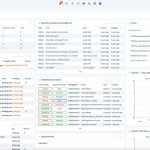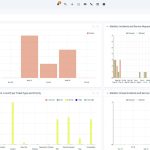Enterprise Service Management (ESM) Software

In today’s digital business world, efficient and flexible business and service management solutions are essential. This is exactly where enterprise service management software (ESM) comes into play. It helps companies manage IT departments and other areas like human resources (HR), finance, and customer management. This allows for teamwork across departments without creating information silos.
By automating and standardizing service delivery processes, companies can work more efficiently as well as increase customer satisfaction and transparency.
What is Enterprise Service Management Software (ESM)?
Definition and overview
Enterprise Service Management Software is a platform that standardizes and automates information flows, processes and services in a company. It was once mainly used for IT services in IT Service Management (ITSM). Now, its use has grown to include many other business areas.
The aim is to optimize collaboration within the company. This increases the quality of service provision, efficiency and added value within the company.
Differences between ESM and ITSM
ITSM (IT Service Management) and ESM (Enterprise Service Management) differ primarily in their area of application. ITSM refers specifically to the management of IT services within an organization. It focuses on the provision, management and support of ITSM processes that drive the business. Well-known frameworks such as ITIL (ITIL®️ is a registered trade mark of Axelos Limited. All rights reserved.) and associated ITIL processes are frequently used here.
ESM, on the other hand, uses IT service management (ITSM) principles in other parts of the company. This includes human resources, finance, facility management, and customer service. The aim is to organize all of a company’s internal processes more efficiently.
While ITSM is strongly focused on IT departments, ESM encompasses the entire company. It promotes company-wide optimization of workflows and service processes.
Advantages of Enterprise Service Management Software
Increased efficiency in the company
By automating and standardizing processes, companies save time and resources. With ESM software, recurring tasks can be automated. This reduces the workload and minimizes errors. It reduces processing times and resources are utilized more effectively.
Also, different departments can work together more easily. They can solve problems faster because of the centralized management of requests and processes. ESM’s holistic approach therefore results in higher productivity, better internal coordination, and an improved user experience.
Improved customer satisfaction
Enterprise Service Management (ESM) software improves customer satisfaction by enabling consistent service experiences. By managing service requests and delivering services consistently across different departments, companies can respond more quickly to customer needs and offer customized solutions.
ESM software also makes it possible to track tasks clearly and communicate proactively, which increases transparency for customers. The result is that customers feel better cared for. They see interactions as more reliable and professional. This increases their trust and satisfaction.
Increased transparency and control
Centralized documentation and monitoring provide detailed insights into processes, bottlenecks and responsibilities – an important basis for well-founded decisions. In addition, services can be seamlessly tracked and KPIs analyzed in real time. This central overview helps ensure compliance with guidelines. It also allows us to spot weaknesses early and address them effectively.
More security
Incidents need to be resolved quickly through incident management to minimize the impact on business operations and customers. Automated workflows enable a faster response and escalate critical incidents to the right teams.
Security policies and access rights can also be systematically managed, reducing unauthorized access. Seamless documentation and analysis functions allow causes to be identified efficiently and preventative measures to be taken, increasing overall resilience to security threats.
Core functions of ESM software
- Ticket and incident management
- Automated processes and workflows
- Knowledge management and self-service functions
- Integration of other tools and systems
With these, requests and incidents can be handled in a clear and organized way. The approach shortens response times and improves service quality. Each request is registered as a ‘ticket’ and tracked through predefined workflows until it is resolved by the service desk.
Standardized, automated processes and workflows - via business process management software (BPMS) - form the basis for high-quality services by minimizing manual intervention and automatically executing defined steps. As a result, tasks such as IT services, approval processes or escalation routines can be managed consistently. Processes can be handled efficiently and in accordance with regulations throughout the company.
Automation means that fewer errors occur, and it is easier to meet deadlines or service level agreements (SLAs). The result is improved process stability and increased organizational agility.
A knowledge base in which employees can access important information helps to answer frequently asked questions efficiently and consistently. Centralized storage and management of information, such as FAQs, instructions and problem solutions, facilitates access to proven solutions and supports rapid problem-solving.
This central overview helps ensure compliance with guidelines. It also allows us to spot weaknesses early and address them effectively.
Die Integration anderer Tools und Systeme in eine ESM-Software ermöglicht eine nahtlose Verbindung mit bestehenden Anwendungen wie CRM, ERP oder HR-Systemen. Dadurch lässt sich der Datenfluss automatisieren und Information über verschiedene Plattformen hinweg nutzen.
Mit solchen Integrationen werden redundante Dateneingaben vermieden, Prozessabläufe optimiert und die Effizienz gesteigert. Dies liefert eine umfassende Sicht auf alle relevanten Daten und verbessert die Koordination und Zusammenarbeit zwischen verschiedenen Abteilungen.
With OTRS, you’re perfectly positioned to benefit from ESM principles.
OTRS provides many service management tools. These tools help make your enterprise service management more efficient. They also increase the value of your company.
Your teams and the whole company benefit from clear communication and efficient processes. Benefit from the integrated ticket system, automated business processes, and integration with your existing software solutions.






Which business areas benefit most from ESM?
In principle, all areas of the company benefit from the implementation of an ESM solution. Focus on areas with high demand for service processes as you explore this digital transformation.
IT departments
Enterprise Service Management (ESM) software provides a centralized platform for managing and coordinating all IT services required for efficient IT infrastructure and asset management. This improves the clarity and traceability of IT inquiries, incidents and change requests.
ESM helps connect IT systems and processes. This reduces duplicate tasks and improves information sharing among IT teams. The software also supports adherence to compliance requirements and provides tools for the continuous improvement of IT service quality.
HR and staff management
The central administration, automation and standardization of human resources (HR) processes such as holiday requests, training and recruitment increases the quality and security of processing. Self-service functions allow employees to make inquiries and view information by themselves. This reduces the workload of the HR department. Integration with other systems – such as those for time management or payroll accounting – improves data availability and coordination between the various HR processes.
Service management
Service management benefits from ESM software through the comprehensive automation and standardization of service provision. The software makes it possible to effectively outline services in a service catalog. Customers can initiate service through a service portal.
The software then manages and prioritizes service requests across different departments and improves the transparency of service processes. Integrated reporting and analysis tools enable service managers to monitor performance trends and derive targeted improvement measures.
Services are coordinated and consistent thanks to seamless integration with other company systems.
Choosing the right ESM software
When selecting ESM software, consider factors such as user-friendliness, customizability of workflows and the provider's support services. It is also important that the software fulfils the company's specific requirements.
One crucial aspect is the scalability of the software. Companies should ensure that the ESM solution can grow with the company. It must also be flexible enough to adapt to changing requirements.
Integration with existing systems, such as CRM or ERP, is crucial for a smooth information flow. Other key aspects are user-friendliness and workflow customizability. Comprehensive reporting and analysis tools should also be available to monitor performance all the time and identify optimization potential.
Compliance is essential for secure operations and adherence to data protection regulations.
Rights and role management, encryption technologies and audit functions are also crucial for ensuring data integrity and process traceability. It is also essential that the solution supports regular security updates and certifications. It should also have certifications like ISO 27001 to ensure strong protection.
Implementing enterprise service management software
Challenges
Challenges
The implementation of ESM software brings with it various challenges. These include, in particular, the organizational change required to adapt work processes and the expense of employee training.
Resistance from employees who are skeptical about the changes should be minimized. Include training and employee involvement in the planning process.
Technical hurdles are also complex and should be taken into account during planning. This includes topics such as integration into existing IT landscapes and data migration.
Best practices for successful implementation
Best practices for successful implementation
- Plan carefully
Good planning is a prerequisite for recognizing all possible obstacles and ensuring a successful implementation.
- Remove technical hurdles
Eliminate all technical hurdles. This helps realize the implementation without disruption. It ensures the least possible impact on business operations.
- Rollout gradually
The rollout should take place gradually. This way, obstacles can be responded to and the burden on all parties involved can be minimized as far as possible.
- Train employees
ESM software is only really useful if employees have the expertise to use it comprehensively. In addition, knowing how to use it correctly also reduces potential frustration among employees.
- Set milestones and share successes
Define milestones for the implementation and celebrate the success of the implementation. Milestones provide a clearly defined goal of what is to be achieved and when. In addition, the shared successes motivate everyone involved to continue working on a successful implementation.
Trends
Artificial intelligence and automation
Artificial intelligence (AI) and automation play a central role in the development of enterprise service management software. AI-based systems enable proactive problem detection, automatic prioritization, AI-based summaries of content and personalized service experiences.
Automation optimizes routine processes and reduces manual intervention, resulting in greater efficiency and quality. In the future, AI will increasingly be used to predict service requirements and make intelligent decisions. This enables a continuous improvement in service quality and contributes to the adaptability of companies in dynamic environments.
FAQ
What is the difference between ESM and ITSM?
What is the difference between ESM and ITSM?
ESM extends the concept of ITSM. It addresses all relevant service processes in the company, in addition to IT services.
How long does it take to implement enterprise service management software?
How long does it take to implement enterprise service management software?
This depends on the complexity of the company structure and the software selected. It can take a few weeks to several months.
Is ESM only suitable for large companies?
Is ESM only suitable for large companies?
No, medium-sized companies can also benefit from ESM, especially if they have to coordinate several departments.
Can ESM software be integrated with other software solutions in the company?
Can ESM software be integrated with other software solutions in the company?
Yes, most modern ESM solutions offer integrations with common CRM, ERP and HR systems. The full potential can only be utilized with the integration of other company systems.
Find out how OTRS makes your enterprise service management more efficient.

